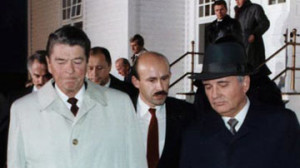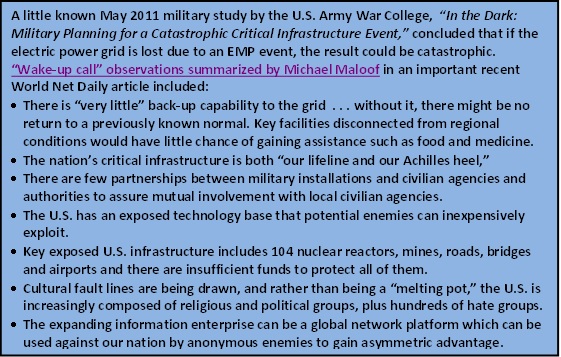Amb. Henry F. Cooper, Chairman Lt. Gen. Daniel Graham, Founder
High Frontier . . Building Truly Effective Defenses . . Reagan’s Vision Lives!
E-Mail Message 130318
Memories . . . and Things Yet to Be . . .
 This week, we celebrate Ronald Reagan’s March 23, 1983 address that launched his Strategic Defense Initiative. Thanks to SDI and those who’ve braved ridicule to stand with President Reagan, Defense Secretary Hagel could say last Friday that we have an “iron-clad” commitment to missile defense, including for our overseas troops, friends and allies. “How sweet it is!” More to come . . .
This week, we celebrate Ronald Reagan’s March 23, 1983 address that launched his Strategic Defense Initiative. Thanks to SDI and those who’ve braved ridicule to stand with President Reagan, Defense Secretary Hagel could say last Friday that we have an “iron-clad” commitment to missile defense, including for our overseas troops, friends and allies. “How sweet it is!” More to come . . .
Next weekend, as we will celebrate the 30th anniversary of Ronald Reagan’s historic address to the nation, we should once again listen to his important challenge to America’s technical community—click here for an excerpt. Those who have stood with President Reagan, accepted his challenge and braved the ridicule of many at that time—and since—enabled Defense Secretary Chuck Hagel to announce last Friday that “The United States has missile defense systems in place to protect us from limited ICBM attacks . . .” He also announced that because North Korea “has recently made advances in its capabilities and is engaged in a series of irresponsible and reckless provocations,” the United States was deploying additional ground based interceptors in Alaska and emphasized the U.S. “iron-clad” commitment to missile defense, including for our overseas troops, friends and allies.
Again, to repeat Jackie Gleason famous exclamation on the Honeymooners, “How sweet it is!”
At least as far as this story goes. But there is more to the story—much more—at least for the High Frontier family that was standing with Reagan even before he gave this historic address. He emphasized his appreciation in his telephone conversation with our founder, Lt. Gen. Danny Graham, on High Frontier’s tenth anniversary in 1991.
Throughout the SDI era of missile defense development, from 1983 to 1993, High Frontier’s vision of a global defense of all basing modes—but with an emphasis on space-based defenses—remained alive and well. In 1993, the Clinton administration dropped the SDI label on missile defense activities and more importantly canceled all activities that could produce the most effective and least expensive defenses against ballistic missiles, namely those based in space. And that potential remains dormant in the current activities now championed by the Obama administration.
Can that part of President Reagan’s vision be revived?
The 1986 Reykjavik Summit illustrated Reagan’s vision.
Many claim that Reagan’s SDI vision has been realized as ground and sea-based defenses are being deployed . . . and without his strong commitment to SDI and building missile defenses, we almost certainly would not have the defenses we have today. But they forget, or ignore, his commitment to space-based defenses as key to his vision for building effective defenses.
 His October 11-12, 1986 Reykjavik Summit with Mikhail Gorbachev illustrated this commitment. Many rightly point out that Reagan rejected an agreement that would have embodied Gorbachev’s concessions on offensive nuclear arms because Gorbachev demanded in exchange that they agree to gut the SDI program. But that rejection was caused by Gorbachev’s specific demand that would have gutted the SDI research on space-based defenses, which would have banned important experiments then being conducted in space. And Reagan was disappointed as is clear from the adjacent photograph taken as the leaders departed from the summit.
His October 11-12, 1986 Reykjavik Summit with Mikhail Gorbachev illustrated this commitment. Many rightly point out that Reagan rejected an agreement that would have embodied Gorbachev’s concessions on offensive nuclear arms because Gorbachev demanded in exchange that they agree to gut the SDI program. But that rejection was caused by Gorbachev’s specific demand that would have gutted the SDI research on space-based defenses, which would have banned important experiments then being conducted in space. And Reagan was disappointed as is clear from the adjacent photograph taken as the leaders departed from the summit.
This summit came on the heels of several rounds of negotiations in Geneva, when I was at the table and well understood the Soviet demands that even research on so-called “space-strike arms” be banned—they defined these code words as referring to space-based defenses as well as all anti-satellite systems and space weapons that could be used to attack targets on the ground. Many attribute Reagan’s walk-out to Gorbachev’s demand that Reagan give up missile defense—but that misrepresents the facts. It was Gorbachev’s specific demand that all research and testing of space based defenses be limited to the laboratory—nothing in space, which would have ended important experiments then being conducted to determine if building an effective space-based defense was possible. (Let it be understood that these experiments demonstrated that it is indeed possible.) Lest there be debate on this point, below is from the declassified U.S. memorandum of conversation just before the meeting broke on October 12:
As it turned out, we satisfied most of our objectives in our talks with the Soviets, and we signed Treaties eliminating Intermediate Range Ballistic Missiles (1987) and producing major reductions in strategic offensive arms (1991) without accepting additional restraints on our ability to conduct SDI research and development, including on space-based defenses. The U.S. Congress and the Clinton administration accomplished what the Soviets were not able to do in the negotiations: first, Congress cut the funds for the “Brilliant Pebbles” space-based defense R&D during my watch in 1992, and the Clinton administration then completely scuttled all R&D on space defenses in early 1993. You can review this sad history in Don Baucomb’s record of the “Rise and Fall of Brilliant Pebbles.”
Perhaps there was a rationale for not pressing Reagan’s vision when we were constrained by the terms of the ABM Treaty, which blocked the development and testing space of based defenses—but also of sea-based, air-based and mobile land-based defenses, where the powers that be permitted R&D to continue. Even after the George W. Bush withdrew from the ABM Treaty in 2002, his administration did nothing to revive developing the key technologies to enable eventual deployment of space defenses, as would have been consistent with Reagan’s vision illustrated at Reykjavik. And the research during my watch as SDI Director already had indicated space defenses could provide global coverage against ballistic missiles of all ranges greater than a few hundred miles—and for far less expense than other basing modes.
These effects are all discussed in substantial detail in the reports of the Independent Working Group, which are linked to the High Frontier webpage. Revival of a serious program to consider the benefits of space-based defenses is an important objective for all who are serious about building truly cost effective defenses.
Many believe that Reagan’s commitment to SDI at the Reykjavik Summit was the turning point in ending the Cold War. Amb. Vernon Walters, then our UN Ambassador, told me at the time that Soviet Marshal Akhromeyev said that Reykjavik was a “watershed event.” He ought to have known, as he led the Soviet experts group at Reykjavik. And as Ronald Reagan’s great friend and partner, British Prime Minister Margaret Thatcher, told us when we hosted her in our SDI National Test Facility in Colorado Springs on August 2, 1990:
“I firmly believe that it was the determination to embark upon the SDI program and continue it that eventually convinced the Soviet Union that they could never, never, never achieve their aim by military might because they would never, never succeed.”
Things yet to be?
Let us hope that the past is prologue and that the powers that be will eventually restore a serious examination of space-based defenses among those being developed and deployed today. This is unfinished business if we are to realize Ronald Reagan’s vision, embodied in his challenge that energized the scientific community 30 years ago and that he so memorably demonstrated at Reykjavik.
Last week, Defense Secretary Hagel emphasized the Obama administration’s commitment to missile defenses and announced that we will deploy 14 additional ground-based interceptors in Alaska. We need truly effective defenses, and we should not leave out considering the most cost-effective systems possible—those based in space.
The threat from North Korea has everyone’s attention—but there are other threats as well, as we have discussed in our precious email reports. The administration’s initiatives, while welcome, do not deal with them all. For example, they do not deal at all with the threat from vessels off our coasts—a near term existential threat if even a short range missile is launched from its deck to detonate a nuclear weapon at high altitude over the United States. The resulting electromagnetic pulse (EMP) could lead to the demise of over a hundred million Americans during the next year.
As comprehensive analyses are conducted to consider the full panoply of ballistic missile threats, the advantages of space defenses should become apparent. We believe that unbiased analysis will validate what was intuitively clear to Ronald Reagan.
William R. Van Cleave, RIP.
We were so sorry to learn that Dr. Bill Van Cleave passed from this life around noon (PST) on Friday, March 15, 2013. Word images abound: Patriot, Marine, Professor, Mentor, Student, Historian, Strategist, Activist, Advocate, Friend. Among his many credits is that he led the Defense Advisors during Ronald Reagan’s 1980 campaign and the Defense Transition Team following his election. He was a prime mover in instigating and pursuing Reagan’s modernization programs to repair our then atrophying strategic forces. A tireless critic of faulty arms control thinking and negotiations, he was the only member of the SALT I Delegation to testify against the ratification of SALT I and particularly the ABM Treaty, and his judgments were borne out by subsequent events—it took thirty years to free ourselves from that strategic error and to begin to realize the alternate vision advocated by Ronald Reagan that included a major role for effective defenses. Bill’s legacy includes a most impressive cadre of former students, from his days at the University of Southern California and Missouri State University, who lead in many important arenas in government and the private sector. We who survive have much to emulate to continue the work he did. Especially, those of us who participate with the Independent Working Group will sorely miss him and his contributions. May God rest his soul and give him eternal peace.
And what should you do?
Join us at High Frontier in seeking to alert the public to the existential threats posed by both manmade and natural EMP events—and what can be done about these threats.
We can use your help in spreading the word to grass roots and local authorities to press the powers that be to provide for the common defense as they are sworn to do. Will you do your part?
Begin by passing this message to your friends and suggest they visit our webpage, www.highfrontier.org for more information. Also, please encourage your sphere of influence to sign up for our weekly e-newsletter!
Please follow us on Facebook, Twitter, and Youtube!
Help support the work of High Frontier!





